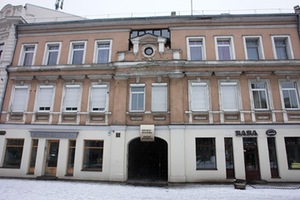ARCHITECT R. J. PALYS: 'CULTURE HERITAGE IS NOT JUST MASONRY OR ARCHS – IT IS HUMAN RELATIONS, SPACES, HABITS, TRADITIONS, MEMORABLE PLACES' 2
In brief: The architect Rimvydas Palys compares problems of Kaunas’ architectural heritage to a sick patient: solving every case separately is more important than diagnosing from books. It is relevant to evaluate the situation in terms of space and context, not laws only. In his opinion, the patient can be cured – good contemporary architecture would help more than attempts to recreate the mighty past.
R. Palys hesitates to answer unambiguously if it is meaningful to expand protected territories in the city centre. The problem of new architecture in the historical environment is actually the problem of good architecture. If all architects had a sense of space, were talented and smart, no instructions, norms or regulations would be needed.
Kaunas was developed as a city-fortress of the Tsar period. There were many wooden houses, cobbled streets, wooden pavements, a horse-drawn tram. In the interwar period modern buildings were built in Kaunas because there was no such concept as architectural heritage. Such excellent buildings as Milk Centre, Trade Union House and Clinic appeared. Kaunas acquired a unique identity and the unified impression of interwar modernism.
However, today a new wave of constructions began – sometimes based on greed. The architect believes that the expansion should be allowed but only by creating new values with sensitivity and preserving the old ones.
When asked if the preservation of the authentic Kaunas Old Town was successful, R. Palys had a double opinion. Kaunas is lucky compared to other Lithuanian cities – it has two rivers, bank slopes, was a cradle of modernism of the whole country, little Paris with a bourgeois culture. However, the Old Town is rather mediocre. Many quarters were ruined, certain zones were isolated because of traffic, 90% of the houses were simulated (gothic cellars combined with pseudo-classicism, etc). However, this simulation was real and unified; it was a city of Europe with ornamented houses, narrow or broad showcases with shutters – these are those layers of the authenticity. Unfortunately, much harm was done during the Soviet era.
What is better – simulation or a pile of ruins? First of all, Lithuanians should decide what the heritage means for them. If there are real ruins of a castle – should the castle be rebuilt again to raise the strength of the nation? It might be fun enough but very unfair.
The identity of Kaunas, those most relevant qualities that must be cherished are still undefined. It could be such priorities as history of navigation, steamboat port in the centre, modernist architecture as entity, slopes, banks of the river Neris, fortresses, memorable places (cafes and cinema theatres), traditional names, places of rendezvous with the old function.
One should focus on the already agreed aspects: do not create simulation; if you create something, new elements should be obviously seen; if there is a development done, new values should not destroy the old ones. The old spirit could be supplemented with contemporary formations and the new architecture should not be avoided if it is good.
Finally asked, if the Soviet era architecture was really a parasite destroying the heritage, the architect answered that the period itself could not define the architectural value. A house that was built yesterday could also be worth to be preserved – on the condition that it is good.
Photographs by Austėja Masiokaitė











